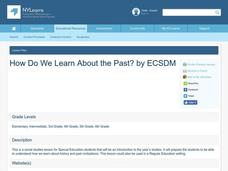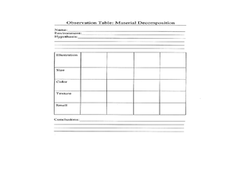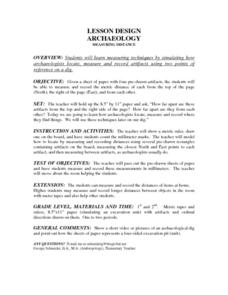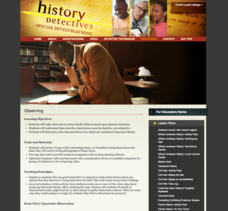Curated OER
Sticks, Stones, Sinews and Stuff: How Early People Used the Environment to Meet Basic Needs
Students create an artifact. In this early survival lesson plan, students use found objects to create an artifact that could have been used to help early people meet their basic needs.
Curated OER
How Do We Learn About the Past?
Students examine archaeological discoveries. In this learning about the past lesson, students view a "Magic School Bus" video, discuss the role of an archeologist, and complete a graphic organizer. Students discuss a variety of artifacts...
Curated OER
Building Bridges for Young Learners--Culture
Students explore the concept of "culture." In this cross curriculum literacy and world history lesson, students listen to a letter written by a child from Namibia, then compare and contrast life in Africa with their own life. Students...
Curated OER
What Artifacts Reveal About The Past
Students take a closer look at artifacts to learn about the people who used them. In this colonial America lesson, students examine photographs of everyday items used in colonial times and determine what the uses of the tools may be...
Curated OER
What did I find?
Students excavate an artifact. In this archaeology lesson, students get a bucket filled with dirt and a broken up artifact. They work in groups to take it out and to find what its purpose was.
Curated OER
Slow Rot or Not?
Fifth graders examine how environmental factors affect decomposition. In this decomposition lesson, 5th graders experiment with the decomposition of grapes in five different environmental settings. They look at images of items that have...
Curated OER
Lesson Design Archaeology- Measuring Distance
Students measure and write specific metric distances. In this archaeology lesson, students are given specific artifact locations on a map and measure the distance using millimeters.
Curated OER
The Museum Idea
Young scholars evaluate and record the various types of museum careers. In this The Museum Idea activity, students create a bicentennial time capsule, design a Museum of me, and make a classroom mini museum. In addition young scholars...
Curated OER
The Torah Tells...
Young scholars extract and interpret information about the Torah text to draw conclusions about ancient Hebrew life. In this Torah lesson plan students research facts and complete worksheets about the Torah. Then as a class the young...
Curated OER
Life in Ancient Mesopotamia
Students reconstruct and make drawings of vessels in the same manner as an archaeologist. In this archaeologist lesson plan, students each get a piece of a broken pot and they have to work together to put it back together. Once it is...
PBS
Looking for Lincoln Throughout His Life
Young historians gather information about Abraham Lincoln through a variety of activities. They match vocabulary words with pictures to create a timeline. Additionally, learners read books and articles that teach them...
Curated OER
The Stories They Tell -- Graveyard Data Collection Worksheet
In this folk culture research worksheet, students use the form to record data about a graveyard that they visit to show that graveyards reflect how cultures change and differ from each other.
Curated OER
Lone Star Round-Up
Students take a virtual tour of the Capitol Visitors Center in Austin, Texas. In groups, they receive a list of the artifacts and symbols they are to look for during their exploration of the building. To end the activity, they make a...
Curated OER
The Family: Louisiana Family Folklore
Learners explore and identify family treasures and research the history to each one. They also organize a variety of artifacts into various categories and research traditional Louisiana artifacts online. Each student draws inferences...
Curated OER
Social Studies: Exploring Boston's Big Dig
Students, in a high school class for autistic children, take a virtual tour of Boston's "Big Dig" and the artifacts discovered there. During weekly lab sessions, they discover the processes involved in artifact preservation. Using...
Curated OER
Real-Life History
Students collect artifacts which are part of their family/community history. They gather at home and share in the classroom at a specified time when extra care and supervision might be provided.
Curated OER
Contextual Clues
Students observe and interpret images of artifacts in different contexts in order to recognize importance of leaving artifacts in original context to correctly understand their meaning, and observe what is surrounding object to interpret...
Curated OER
Artifact Identification-What is it?
Students observe an artifact and make an inference about the artifact's purpose. They are going to role-play as archaeologists by using artifacts to hypothesize about the lives of past people.
Curated OER
Dr. Dirt's Archaeology Lab Artifact Analysis
Students simulate analyzing artifacts in archaeological lab by using real techniques that archaeologists use. Students practice measuring skills, drawing, writing, and brainstorming, and make inferences based on evidence.
Curated OER
What Do We Learn From the Repartiation of Alaska Native Artifacts?
Middle schoolers observe and evaluate evidence of Alaska Native cultural symbols and artifacts. They research historical data from a variety of primary resources, including the Harriman expedition journals, related web sites, oral...
Curated OER
Blast from the Past
Students analyze historic artifacts to help gain an understanding of how the past has impacted their lives. They explain ways "design" can be both a noun and a verb. Students use internet resources to view and learn about artifacts that...
PBS
Predicting/Making a Hypothesis
Students analyze information from a variety of sources in order to create a hypothesis about the origin of an interesting family artifact.They create alternative hypotheses based upon available information to demonstrate that some...
PBS
Scavenger Hunt
Learners conduct field research of a historical site in order to discover a more complete understanding of a time period. They visit a site of historical significance and complete a scavenger hunt about the area.
PBS
Observation
Students study making scientific observations . They conduct a "field study" in their attic and make observations about their family artifacts based upon physical attributes. In addition, they determine what characteristics of an object...

























